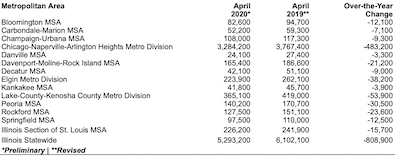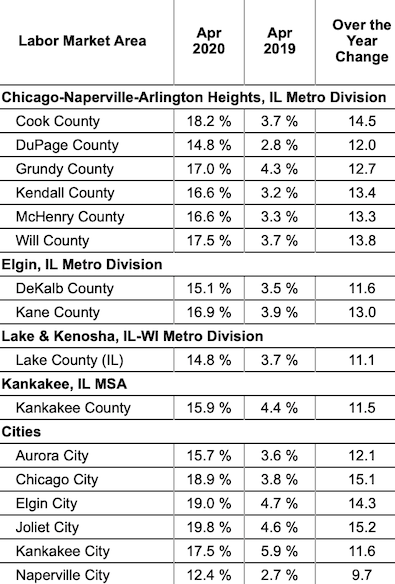
Total Nonfarm Jobs (Not Seasonally Adjusted) – April 2020

Not Seasonally Adjusted Unemployment Rates (percent) for Local Counties and Areas

Latest Post | Last 10 Posts | Archives
Previous Post: School seclusion and restraint bill derailed after opposition
Next Post: COVID-19 roundup
Posted in:
The number of nonfarm jobs decreased over-the-year in April in all fourteen Illinois metropolitan areas, with six metro areas at record low payrolls, according to preliminary data released today by the U.S. Bureau of Labor Statistics (BLS) and the Illinois Department of Employment Security (IDES). Data also shows that the unemployment rate increased over-the-year in all metro areas to record highs for the month of April as the COVID-19 pandemic continued to impact local areas across the state. The official, BLS approved, sub-state unemployment rate and nonfarm jobs series begins in 1990. Data reported prior to 1990 are not directly comparable due to updates in methodology.
“With every corner of our nation impacted by the COVID-19 pandemic, it is time for the federal government to provide state and local governments with additional relief,” said Deputy Governor Dan Hynes. “Our administration is focused on helping small businesses rebuild and ensuring working families recover as communities across the state begin safely reopening their economies next week.”
Data shows the number of nonfarm jobs decreased in all fourteen Illinois metropolitan areas. Total nonfarm jobs were down in Peoria (-17.9%, -30,500), Decatur (-17.6%, -9,000) and Rockford (-15.6%, -23,600). Jobs were down -12.8% (-483,200) in Chicago-Naperville-Arlington Heights. Job losses occurred across all industries and there were no industry sectors that recorded job growth in a majority of metro areas.
Not seasonally adjusted data compares April 2020 with April 2019. The not seasonally adjusted Illinois rate was 16.9 percent in April 2020, a record high for the month of April, dating back to 1976. Nationally, the not seasonally adjusted unemployment rate was 14.4 percent in April 2020, also a record high, dating back to 1948. The unemployment rate identifies those individuals who are out of work and seeking employment.
* More…

Total Nonfarm Jobs (Not Seasonally Adjusted) – April 2020

Not Seasonally Adjusted Unemployment Rates (percent) for Local Counties and Areas

* And…
Kankakee, IL MSA
The not seasonally adjusted unemployment rate increased to 15.9 percent in April 2020 from 4.4 percent in April 2019. The April 2020 unemployment rate is the highest April unemployment rate on record.
Total nonfarm employment decreased -3,900 compared to April 2019. The Leisure-Hospitality (-800), Manufacturing (-700), and Educational-Health Services (-600) sectors recorded the largest employment declines compared to one year ago.
Chicago-Naperville-Arlington Heights, IL Metro Division
The not seasonally adjusted unemployment rate increased to 17.6 percent in April 2020 from 3.5 percent in April 2019. The April 2020 unemployment rate is the highest April unemployment rate on record.
Total nonfarm employment decreased -483,200 compared to April 2019. The Leisure-Hospitality (-200,500), Professional-Business Services (-64,700), Retail Trade (-47,000), and Educational-Health Services (-44,100) sectors recorded the largest employment declines compared to one year ago.
Elgin, IL Metro Division
The not seasonally adjusted unemployment rate increased to 16.6 percent in April 2020 from 3.9 percent in April 2019. The April 2020 unemployment rate is the highest April unemployment rate on record.
Total nonfarm employment decreased -38,200 compared to April 2019. The Leisure-Hospitality (-12,400), Educational-Health Services (-4,900), and Manufacturing (-4,500) sectors recorded the largest employment declines compared to one year ago.
Lake & Kenosha Counties, IL-WI Metro Division
The not seasonally adjusted unemployment rate increased to 15.1 percent in April 2020 from 3.7 percent in April 2019. The April 2020 unemployment rate is the highest April unemployment rate on record.
Total nonfarm employment decreased -53,900 compared to April 2019. Leisure-Hospitality (-19,500), Professional-Business Services (-10,700), and Retail Trade (-8,100) sectors recorded the largest employment declines compared to one year ago.
posted by Rich Miller
Friday, May 29, 20 @ 12:15 pm
Sorry, comments are closed at this time.
Previous Post: School seclusion and restraint bill derailed after opposition
Next Post: COVID-19 roundup
WordPress Mobile Edition available at alexking.org.
powered by WordPress.
When did Elgin become its own metro area?
Comment by All this Friday, May 29, 20 @ 12:38 pm
===When did Elgin become its own metro area?===
It’s not, it is a subdivision (Metro Division) of the larger MSA just like Lake-Kenosha and Chicago-Naperville-Arlington Heights. The official name of the larger MSA is “Chicago-Naperville-Elgin, IL-IN-WI Metropolitan Statistical Area”.
Comment by Six Degrees of Separation Friday, May 29, 20 @ 2:59 pm